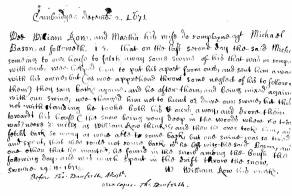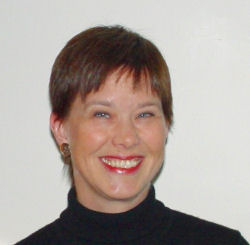|
the case of the purloined pigs
By
Diane Rapaport
Anyone familiar with Lexington, Massachusetts, has seen the
name Munroe—on the Munroe Tavern, the Munroe Center for the Arts, and
Munroe Road, to cite a few examples. The first Lexington Munroe, then
spelled Munro or Munrow or sometimes just Row, was a Scotsman named
William, who arrived at Boston Harbor with a shipload of other Scottish
war prisoners in 1652. He worked as an indentured servant in Menotomy
(today’s Arlington), earned his freedom, and settled in Cambridge Farms,
as Lexington then was known.
Most of what we know about William Munro—where he bought
land and whom he married and when his children were born—tell us little
about the kind of man he was. But underused old court records still
preserve stories from the lives of people like Munro, often in their own
words. One such file from the Massachusetts Archives, Row v. Bacon,
tells of Munro’s stubborn quest for justice against an arrogant foe. I
call this lawsuit “The Case of the Purloined Pigs.”

The problems started on a Monday in late November 1671,
after a heavy snowfall in a remote corner of Cambridge Farms, near today’s
intersection of Lowell and Woburn Streets. Here, at the house where Munro
lived with his wife Martha and three small children, a neighbor arrived
looking for his hogs.
Michael Bacon (his real name!) had a reputation for letting
his hogs run wild, and this time they had wandered all the way from
Bacon’s house (in present-day Bedford) to enjoy the companionship of
Munro’s own pigs. Munro and his wife, wanting only to be rid of the
uninvited swine guests depleting their meager forage, helped Bacon to
separate his hogs from their own. Bacon then headed off through the woods
with his swine, and the Munros returned to their daily chores.
But Bacon’s hogs apparently did not want to leave their
friends, and they soon came back. This time, when Bacon returned to
retrieve them, he did not bother to sort them out; he just drove off the
whole lot. Seeing most of the family’s worldly wealth hoofing away, Martha
shouted at Bacon to stop, but he ignored her. William, who was occupied
feeding the oxen or fetching firewood, had to drop everything, strap on
snowshoes and take off in pursuit.
Munro was not a man to be trifled with. He had endured many
hardships—on the battlefield, in a prison camp, during the long Atlantic
crossing, and as an indentured servant. Now he was free to farm his own
little piece of land, and those pigs were crucial to his family’s
survival. Hogs meant meat on the table and income to buy other necessities
of life, and Munro could not afford to lose a single animal.
He also knew that Michael Bacon could not be trusted. If
the old court records are any indication, Bacon was known throughout the
county for making trouble. His hogs had damaged crops for miles around,
but he always denied responsibility, blaming others for failing to keep
their fences in repair or claiming that the hogs belonged to someone else.
Bacon’s name appears repeatedly in land disputes, cases of wandering
horses and cattle, slander and forgery accusations, breach of contract,
even a paternity case. Thus, when Munro set off in the snow after Bacon
and his pigs, he had good reason to expect problems.
Munro trudged north through three miles of drifted snow,
following hog tracks until he finally overtook Bacon and found most of his
livestock. One pregnant sow was "so tired and spent that shee could not
come back," and he had to leave her with Bacon. Another sow, also "big
with pig," was missing. Munro was angry, but nothing more could be done
before nightfall. He drove the rest of his hogs back home.
The next day, Munro sought out constable’s deputy John
Gleison and his brother William. He showed them the hoof‑trodden farmyard
and the path through the woods, and together they trekked back to Bacon’s
house to retrieve the last two swine. Bacon’s response was predictable.
First he pretended the incident never happened. Then, when the Gleisons
clearly were not accepting that story, he “confessed that William Rows
swine was with him in the drift the day before, but...he did them no
wrong,” and he had none of them “in his hands” now. “If Row lost them, he
must go look for them.” Bacon, of course, did not offer to help.
On Wednesday, the weary Munro turned to his neighbors John
and Benjamin Russell, and together they scoured the woods for the missing
hogs. They found one, stuck in a drift, amazingly still alive, and with
"much difficulty" they brought her home.
One sow was still missing, and Munro’s patience was running
out. He took the law‑abiding next step, which required yet another long
journey on foot through the snow. He walked to Cambridge, to magistrate
Thomas Danforth’s house overlooking Harvard College, where he filed a
claim against Bacon. The amount in controversy was small enough that the
magistrate could resolve the dispute without resort to the courts.
Danforth took up quill pen to issue a warrant, ordering Michael Bacon "to
appeare before me at my house, the last day of the weeke at 12. of the
clock to answear the complaint of William Row, for violence done him in
taking away his swine out of his yard, & driving them away...."

Complaint
of "William Row and Martha his wife" against Michael Bacon, December 2,
1671,
as recorded by Cambridge magistrate Thomas Danforth. Courtesy of Supreme
Judicial Court of Massachusetts, Division of Archives and Records
Preservation."
At the appointed time, six people—William and Martha Munro,
the Russells, and the Gleison brothers—crowded into the magistrate’s study
to testify. Danforth recorded the evidence with careful penmanship, and
the witnesses all signed with their marks. Michael Bacon was not there and
he lost the case. The constable’s deputy set out to seize a "branded
steere" from Bacon to ensure payment of Munro’s damages.
Shortly thereafter, before Munro could collect a single
shilling, his missing sow reappeared at his door. She was “lamed and went
but upon three legs,” delivered by a man who claimed that he "found" her
and was asked by Bacon to bring her home.
Bacon probably hoped that returning the sow would get him
off the hook for damages, but Munro stood firm. In late December, Bacon
asked for a rehearing, which Danforth granted on January 29. The result
was the same, only now Bacon owed more, reflecting the added costs for
witness time and constable’s fees.
Still Bacon refused to pay, and he mounted a vigorous
appeal, seeking a jury trial in the Middlesex County Court. He hired
Concord lawyer John Hoare to draft a tedious petition with a long series
of technical arguments, from improper service of the attachment on his
steer to misfeasance by the well‑respected Danforth. The trial took place
in Cambridge on April 2, 1672, probably at the local Blue Anchor Tavern
(as was customary in those days, since only Boston had courtroom
facilities). Someone apparently represented Munro at the trial (although
his identity is not known), for an elegantly‑written legal argument
appeared in the court records on Munro’s behalf.
The final result, after more than four months of legal
wrangling, was judgment again in favor of Munro: “One Pound sixteen
shillings & foure pence,” plus court costs, a goodly sum, but probably
less a financial boost than a moral victory for the dogged Scotsman.
Presumably Bacon paid up, for here the paper trail of Row v. Bacon
ends. Munro returned to a quiet farming life, but Bacon continued to keep
the courts busy in disputes with other neighbors. Anyone who thinks that
the “litigation explosion” is a modern phenomenon should read the
seventeenth-century court records!
 Diane
Rapaport is a former trial lawyer who has made a new career as a writer,
historian and genealogist. One of her special interests is the
little-known story of Scottish war prisoners exiled to the American
colonies in the mid 1600s. She has spent years tracing the fate of these
Scotsmen, and her articles have appeared in
New England Ancestors,
The Highlander,
History Scotland
and other publications. Her e-mail
address is
rapaports@aol.com. Diane
Rapaport is a former trial lawyer who has made a new career as a writer,
historian and genealogist. One of her special interests is the
little-known story of Scottish war prisoners exiled to the American
colonies in the mid 1600s. She has spent years tracing the fate of these
Scotsmen, and her articles have appeared in
New England Ancestors,
The Highlander,
History Scotland
and other publications. Her e-mail
address is
rapaports@aol.com.
© 2002 Diane Rapaport -
all rights reserved
Note:
This article appeared in the Winter 2004 issue of
New England Ancestors
magazine and is reprinted by permission of the New England Historic
Genealogical Society. (See Diane Rapaport, New England
Ancestors 5 (Winter 2004): 54-55.) For more information about New
England Ancestors and the New England Historic Genealogical Society,
please visit
www.NewEnglandAncestors.org. |
